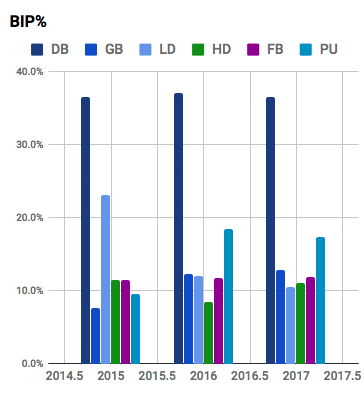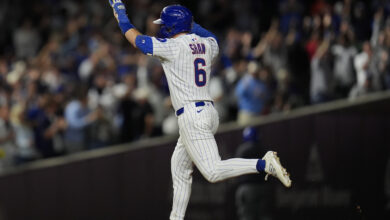
Can We Believe the Increased Power of Javy ‘El Mago’ Baez?
“If you listen carefully when Baez swings from his heels and makes solid contact, you’ll hear both a thunderclap and a choir of angels singing hosannas to the fastest bat in the minors,” said Baseball Prospectus a few years ago. And just last year, the same outlet said, “Because so much has gone well for Cubs prospects of late, it is easy to forget that perhaps [Baez is] the most powerful hitter in the system.”
In contrast to scouting reports and the eye test, Javy’s isolated power last year was a mere .150 in 450 plate appearances, which was seven percent below the league average. Surprising, I’d say, from a hitter heralded for making crowds ooh and ahh, though the highlight-reel infielder still produced a respectable 94 wRC+ and 2.7 fWAR despite the odd power reduction.
Going into 2017, I would have taken more of the same if it meant 3 fWAR. But we’re getting even better offensive production this year, in part due to a power display Baseball Prospectus envisioned three years ago. El Mago has smashed a career-high 16 homers in 332 plate appearances so far, all while posting a .328 wOBA and .225 ISO. That power isn’t a fluke, either.
Javy’s .493 slugging percentage is close to what Statcast expected (xStats xSLG of .449), even though there’s an obvious difference between hypothetical and actual slugging rates. Nevertheless, the 25-year-old’s 2017 xSLG is much higher than last year’s xSLG of .392. Simply put, Javy’s power showcase has been the real deal, finally.
Baez’s power is directly tied to an increased frequency of balls hit between 19-26 degrees, otherwise known as “high drives.” He’s hitting nearly 30 percent more high drives this year compared to last year, illustrated by the green bars below. As Andrew Perpetua pointed out, high drives are the most valuable batted ball type, with a correlated wOBA of .730.
Even better, he’s hitting fly balls (FB below) 1.5 mph harder than compared to last year.
Both the increased frequency of high drives and velocity of fly balls have contributed to a substantial increase in doubles and homers. At the same time, though, the infielder we feel is so close to superstardom is whiffing at a potentially worrisome 35 percent rate. Yet when Baez makes contact near the league-average rate, his power suffers, as proven by last year’s 27 percent whiff rate and resulting .150 ISO. If you want powerful Javy, you might have to live with the whiffs. It’s what Joe Maddon described as “the John Daly approach.”
I personally don’t buy into the idea that Baez can’t hit for power and contact. Not at all. He’s willing to adjust and has successfully done so in his short career. There are times when he exhibits the ability to shorten up, especially in two-strike counts, proving he can cut down on whiffs. When Theo Epstein says development isn’t linear, Baez stands as a prime example.
And if that’s true, we’ve yet to see El Mago’s prestige.



